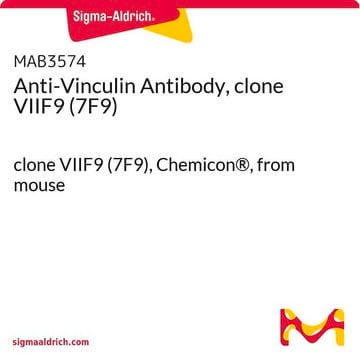There are no available papers that cite using clone VIN-11-5 with Drosophila vinculin. The specific epitope for this antibody has not been mapped. However, there is a paper that maps the epitope binding area of this antibody clone - JBC 266, 8734-8740. 1991, Fusun Kilic, et al. --> "Hence the epitope lies between cysteines 545 and 737." Please see the link below to review this publication:
https://www.sciencedirect.com/science/article/pii/S0021925818315072?via%3Dihub
V4505
Anti-Vinculin Antibody
mouse monoclonal, VIN-11-5
Sinónimos:
Vinculin Antibody Sigma, Anti-VCL
About This Item
Productos recomendados
Nombre del producto
Monoclonal Anti-Vinculin antibody produced in mouse, clone VIN-11-5, ascites fluid
biological source
mouse
Quality Level
conjugate
unconjugated
antibody form
ascites fluid
antibody product type
primary antibodies
clone
VIN-11-5, monoclonal
mol wt
antigen 116 kDa
species reactivity
bovine, human, chicken, mouse
technique(s)
indirect immunofluorescence: 1:50 using cultured chicken fibroblasts
microarray: suitable
western blot: suitable
isotype
IgG1
UniProt accession no.
application(s)
research pathology
shipped in
dry ice
storage temp.
−20°C
target post-translational modification
unmodified
Gene Information
human ... VCL(7414)
mouse ... Vcl(22330)
Categorías relacionadas
General description
Specificity
Immunogen
Application
- western blotting.
- immunofluorescence.[1]
- immunocytochemistry.
Biochem/physiol Actions
Other Notes
SAB4200729 Anti-Vinculin antibody, Mouse monoclonal
clone VIN-11-5, purified from hybridoma cell culture
Disclaimer
¿No encuentra el producto adecuado?
Pruebe nuestro Herramienta de selección de productos.
Optional
Related product
Storage Class
13 - Non Combustible Solids
wgk_germany
WGK 1
flash_point_f
Not applicable
flash_point_c
Not applicable
Elija entre una de las versiones más recientes:
Certificados de análisis (COA)
¿No ve la versión correcta?
Si necesita una versión concreta, puede buscar un certificado específico por el número de lote.
¿Ya tiene este producto?
Encuentre la documentación para los productos que ha comprado recientemente en la Biblioteca de documentos.
-
Hello! Has it been published or predicted if this antibody will react with Drosophila vinculin? Or, could you provide where in the human vinculin this antibody interacts?
1 answer-
Helpful?
-
Active Filters
Nuestro equipo de científicos tiene experiencia en todas las áreas de investigación: Ciencias de la vida, Ciencia de los materiales, Síntesis química, Cromatografía, Analítica y muchas otras.
Póngase en contacto con el Servicio técnico







